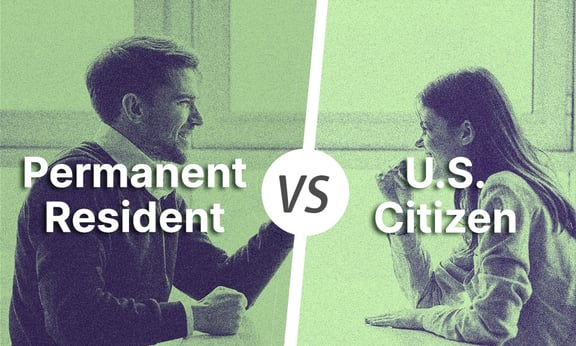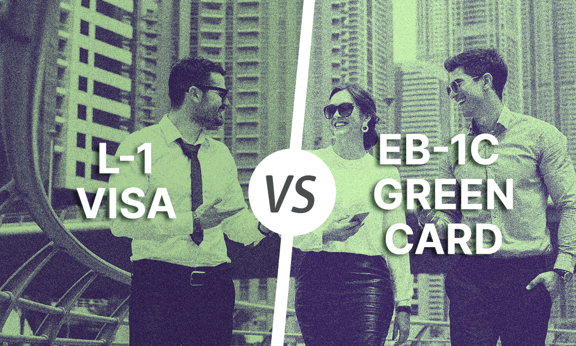Coming to the U.S. requires different documents depending on your purpose of visit. If you are looking for a temporary stay, you should explore non-immigrant visas to see which one is better for your visit. However, if you plan on building a life in the U.S. permanently, you are required to apply for immigrant visas (Green Card or permanent residency card).
Immigrant visas and nonimmigrant visas are two different types of visas issued by the U.S. government that allow individuals to enter the country. An immigrant visa is issued to an individual who intends to live permanently in the U.S. and apply for a green card. An individual with an immigrant visa can apply for permanent residency after entering the U.S.
On the other hand, a nonimmigrant visa is issued to an individual who intends to visit the U.S. temporarily for a specific purpose such as tourism, business, education, or work, and does not intend to stay permanently. Nonimmigrant visa holders are allowed to stay in the U.S. for a specific period of time and must leave the country before their visa expires.
If you are not a citizen of the United States, you may be wondering about the differences between a green card and a visa. Both allow you to live and work in the United States, but there are some key differences to be aware of. A green card grants an individual the legal right to live and work in the United States permanently. It is the first step towards becoming a U.S. citizen. But immigrant visas are issued by U.S. consular officials at embassies or consulates outside of the United States. Immigrant Visas allow an individual to enter the U.S. for the purpose of becoming a permanent resident.
The main difference between a green card and an immigrant visa is that a green card is issued to individuals who are already inside the U.S., whereas an immigrant visa is issued to individuals who are outside the U.S. and wish to enter the country for the purpose of becoming permanent residents. In both cases, the individual must go through a process of applying and being approved before they can receive the card or visa.
In this blog, we will explain U.S. visas and Green Cards. We will point out their differences to inform you best before you set out on your journey to the United States of America!
Understanding the Differences between a Visa and a Green Card
A visa is an official document that allows a foreign national to enter the United States for a specific purpose, such as tourism, study, or work. There are several types of visas available, including tourist visas, student visas, and work visas. Each type of visa has its own set of requirements, and the process for obtaining one can vary depending on the type of visa and the individual’s situation.
A green card, on the other hand, is a document that grants a foreign national permanent legal residence in the United States. With a green card, an individual is able to live and work in the United States indefinitely and can also apply for U.S. citizenship after a certain period of time. Obtaining a green card is a more complex process than obtaining a visa, and typically requires sponsorship from an employer or a family member who is a U.S. citizen or green card holder.
The visitors are asked to have their visa while they are entering the U.S. In order to have it, the applicants must apply for a U.S. visa in their country of origin. Therefore, you should apply through your home country’s U.S. consulates or embassies.
The Types of Visas: Immigrant and Non-Immigrant
The eligibility criteria for the visas are varied. So, the applicant should understand whether they fulfill the requirements and, if so, what documents they are asked to submit during the application process. Once the applicant obtains their visa and arrives in the U.S., they should be cautious about meeting the requirements of their period of residence. If they fail to leave the country once their visa expires, they might have difficulty receiving another visa approval. The extension of the visa could be possible depending on the category of the visa the visitor has. Lastly, it is not possible to proceed with the process of citizenship with the visa.
U.S. visas are divided into two categories: nonimmigrant and immigrant visas.
Nonimmigrant Visas
Nonimmigrant visas are issued to applicants who come to the U.S. temporarily. They need to assure the U.S. government that they will not seek permanent residency while in the United States. This visa category includes tourism, study, and particular employment, such as B-1 and B-2 Visitor Visas, E-1 Visa, E-2 Visa, F-1 Visa, L-1 Visa, O-1 Visa, and H-1B Visa, etc.
Moreover, some visas are issued for applicants who have dual intent. It means that an individual could enter the U.S. and consider applying for permanent immigration at some time in the future, for example, H-1B Temporary Workers in a Specialty Occupation Visa and O-1 Individual with Extraordinary Ability or Achievement.
Immigrant Visas
Immigrant visas are divided into two main categories: family-based and employment-based. Family-based visas are for individuals who have a close family member who is a U.S. citizen or green card holder and wish to join them in the United States. Employment-based visas are for individuals who have a job offer from a U.S. employer and wish to work in the United States. Both of these categories have different requirements, and the process for obtaining one can vary depending on the type of visa and the individual’s situation.
It’s important to understand the difference between immigrant and non-immigrant visas and how they relate to a green card. A green card grants an individual permanent legal residence in the United States, while a non-immigrant visa is temporary and allows an individual to enter the United States for a specific purpose. On the other hand, an immigrant visa is for individuals who wish to permanently immigrate to the United States and obtain a green card.
Read more about specific visa types and their requirement on our website.
Green Cards – The Road to Permanent Residency
Green Cards are physical cards that allow their holders to live and work in the United States permanently. Green Cards allow people to pursue U.S. citizenship after a certain period of stay. In another word, Green Cards are immigrant visas without any legal stay limits. U.S. Visas and Green Cards can be applied for while the applicant is in the United State. However, they are issued after you arrive in America; this is, of course, if you apply for a green card outside of the U.S.
While applying to U.S. Visas, the applicant is not asked for sponsors such as through family or employment. However, to apply for Green Cards, the applicant must have a sponsor. The process of applying for a Green Card is far more complicated than a U.S. Visa application as they are asked to submit more documents.
If the applicant is in the U.S. with an immigrant visa, they can obtain their green card via an adjustment of status application. This means that the applicant does not have to return to their home country to complete the visa application process.
If the applicant is not in the U.S., they can apply and be issued their green card through consular processing. There are various green cards available listed under the green card category. Some of them are listed below:
– Green Cards through Employment
– Green Card through Diversity Visa Lottery
– Green Card through Humanitarian Prospects (refugees, victims of human trafficking, asylum seekers, etc.)
To learn more about Green Cards, read our blog titled What is a Green Card and How to Apply for It? on our website.
In Conclusion
The main differences between a green card and a visa are:
– A green card allows you to live and work in the United States indefinitely, while a visa allows you to enter the United States for a specific purpose and a limited time.
– Green card holders are considered permanent residents and are eligible for many of the same benefits as U.S. citizens, while visa holders are not.
– Obtaining a green card is a more complicated process than obtaining a visa.
Contact Us to Plan Your Journey to the USA
A visa and a green card serve different purposes and have different requirements. A visa is a temporary document that allows an individual to enter the United States for a specific purpose, while a green card grants permanent legal residence in the United States. If you are considering immigrating to the United States, it is important to understand the differences between a visa and a green card and to consult with an experienced immigration attorney to help guide you through the process.
At Grape Law, we provide exceptional legal service to our clients who are seeking to obtain their U.S. visas or Green Cards. Our unique team of immigration attorneys will guide, give consultations, and manage your U.S. immigration aspirations. For any inquiries relating to application preparation, process, and visa and green card issuance, please do not hesitate to contact us at info@grapelaw.com or schedule a face-to-face meeting via our calendar to get an all-around consultancy!
Categories











